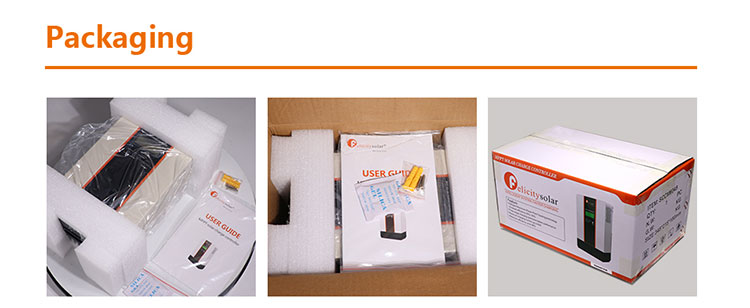
Introduction:
Data Sheet
| Model | SCCM8048 | |||||
| Maximum Solar input Voltage | 145V | |||||
| Nominal System Voltage | 12,24,48VDC(Auto detection) | |||||
| Maximum Battery Current | 45A | |||||
| DC Array MPPT Volage Range | 12VDC/24VDC/48VDC | |||||
| PV Array MPPT Volage Range | 15-115VDC/30-115VDC-60-115VDC | |||||
| Maxinmum input Power | 12Volt-1100Watts | |||||
| 24Volt-2200Watts | ||||||
| 48Volt-4400Watts | ||||||
| Charging Algorithm | 3-Step | |||||
| Charging stages | Bulk,Absorption,Float Bulk,Absorption,Float | |||||
| Temperature compensation coefficient | -5mV/℃/cell(25℃ref.) -5mV/℃/cell(25℃ref.) | |||||
| Temperature compensation range | 0℃ to +50℃ 0℃ to +50℃ | |||||
| Temperature compensated set points | Absorption,Float Absorption,Float | |||||
| Charging Set points | Absorption Stage Absorption Stage Float Stage | |||||
| Flooded Battery | 14.6V/29.2V/58.4V 14.6V/29.2V/58.4V 13.5V/27V/54V | |||||
| ARG/Gel Battery(Default) | 14.1V/28.2V/56.4V 14.1V/28.2V/56.4V 13.5V/27V/54V | |||||
| Overcharge voltage | 15V/30V/60V 15V/30V/60V | |||||
| Overcharge restart voltage | 14.5V/29V/58V 14.5V/29V/58V | |||||
| Battery discharge voltage | 8.5V/17V/34V 8.5V/17V/34V | |||||
| Battery overdischarge voltage | 9V/18V/36V 9V/18V/36V | |||||
| Product size(H*W*D,mm) | 283*180*105mm | |||||
| Product weight(Kg) | 5.1kg | |||||
| Ambient Temperature Range | 0℃ to +55℃ | |||||
| Storage Temperature | -40℃ to 75℃ | |||||
| Humidity | 0%-90%RH(No condensing) | |||||
| Enclosure | IP31(indoor&vented) | |||||



FQA
Q: What's the difference of the PWM charge controller and MPPT charge controller?
A: 1. MPPT controller uses maximum power tracking technology, compared to the PWM controller, the MPPT can generate more electricity with the same solar panels.
2. MPPT controller has low requirement of solar power system voltage, if the line or component parts damage the voltage, using MPPT controller does not affect the system generating.
Q: Why should the controller have temperature compensation function?
A: As temperature rises, electrochemical activity in the battery increases. Similarly, as temperature falls, electrochemical
activity decreases. Therefore, as temperature rises, charging voltage should be reduced to prevent overcharge, as temperature falls, charging voltage should be increase to avoid undercharge. In general, to assure optimum service life, use of a temperature compensated charger is recommended.
Q: How does your factory carry out quality control?
A: Quality is our priority. Our QC always attached great importance to quality control from the very beginning to the end of the production. Each product will be fully assembled and carefully tested before packed.
 X
X